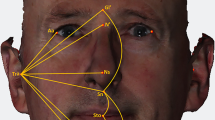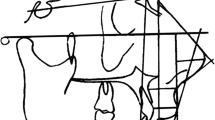Abstract
This study investigates the differences in proportion and structure of the larynx in both children and adults, as well as changes which the larynx undergoes during puberty and adolescence. Furthermore, we have tried to answer the question on the existence of laryngeal sexual dismorphism in pre-pubertal (or pubertal) children. Larynges of 20 adults (10 men and 10 women) and 34 larynges of children not more than 12 years of age were acquired from the Forensic Medicine Department of the Medical University of Warsaw, Poland. Methods used are based on (1) anatomical preparation, (2) anatomical description and (3) measurements performed with the use of a digital camera and a computer-aided system MULTISCAN. Statistics, the Student’s test and Pearson’s linear correlation coefficient were calculated. Results show that proportions of the larynx depend on the age of the individual. The younger the individual is the more slender the larynx would be. However, proportion is not gender-related and hence is about the same in both males and females of any given age-group. Nevertheless, basic parameters were larger in males.




Similar content being viewed by others
References
Ajmani ML, Jain SP, Saxena SK (1980) A metrical study of laryngeal cartilagines and their ossification. Anat Anz 148:42–48
Carr MM, Poje CP, Kingston L, Kielma D, Heard C (2001) Complications in pediatric tracheostomies. Laryngoscope 111:1925–1928
Carter DR, Meyers AD (1979) Anatomy of the subglottic larynx. Otolaryngol Head Neck Surg 87:203–206
Cinar U, Yigit O, Vural C, Alkan S, Kayaoglu S, Dadas B (2003) Level of vocal folds as projected on the exterior thyroid cartilage. Laryngoscope 113:1813–1816
Choi HS, Berke GS, Ye M, Kreiman J (1993) Function of the posterior cricoarytenoid muscle in phonation: in vivo laryngeal model. Otolaryngol Head Neck Surg 109:1043–1051
Dover K, Howdieshell TR, Colborn GL (1996) The dimensions and vascular anatomy of the cricothyroid membrane: relevance to emergent surgical airway access. Clin Anat 9:291–295
Eckel HE, Sittel C, Zorowka P, Jerke A (1994) Dimensions of the laryngeal framework in adults. Surg Radiol Anat 16:31–36
Eckel HE, Sittel C (1995) Morphometry of the larynx in horizontal sections. Am J Otolaryngol 16:40–48
Eckel HE, Koebke J, Sittel C, Sprinzl GM, Pototschnig C, Stennert E (1999) Morphology of the human larynx during the first five years of life studied on whole organ serial sections. Ann Otol Rhinol Laryngol 108:232–238
Eckel HE, Sprinzl GM, Sittel C, Koebke J, Damm M, Stennert E (2000) Anatomy of the glottis and subglottis in the pediatric larynx. HNO 48:501–507
Fishman RA, Pashley NR (1981) A study of the premature neonatal airway. Otolaryngol Head Neck Surg 89:604–607
Garrett CG, Coleman JR, Reinisch L (2000) Comparative histology and vibration of the vocal folds: implications for experimental studies in microlaryngeal surgery. Laryngoscope 110:814–824
Goding GS, Bierbaum RW (1999) Relationship of the posterior cricoarytenoid muscle to the posterior cricoid lamina. Otolaryngol Head Neck Surg 120:493–498
Hirano M, Kurita S, Yukizane K, Hibi S (1989) Asymmetry of the laryngeal framework: a morphologic study of cadaver larynges. Ann Otol Rhinol Laryngol 98:135–140
Kahane J (1978) A morphological study of the human prepubertal and pubertal larynx. Am J Anat 151:11–20
Kasperbauer JL (1998) A biomechanical study of the human cricoarytenoid joint. Laryngoscope 108:1704–1711
Koufman JA, Fortson JK, Strong MS (1983) Predictive factors of cricoid ring size in adults in relation to acquired subglottic stenosis. Otolaryngol Head Neck Surg 91:177–182
Lieberman DE, McCarthy RC, Hiiemae KM, Palmer JB (2001) Ontogeny of postnatal hyoid and larynx descent in humans. Arch Oral Biol 46:117–128
Litman RS, Weissend EE, Shibata D, Westesson PL (2003) Developmental changes of laryngeal dimensions in unparalyzed, sedated children. Anesthesiology 98:41–45
Navsa N, Nossel G, Boon JM (2005) Dimensions of the neonatal cricothyroid membrane—how feasible is a surgical cricothyroidotomy? Paediatr Anaesth 15:402–406
Randestad A, Lindholm CE, Fabian P (2000) Dimensions of the cricoid cartilage and the trachea. Laryngoscope 110:1957–1961
Reidenbach MM (1996) The attachments of the conus elasticus to the laryngeal skeleton: physiologic and clinical implications. Clin Anat 9:363–370
Sasaki CT, Levine PA, Laitman JT, Crelin ES (1977) Postnatal descent of the epiglottis in man. A preliminary report. Arch Otolaryngol 103:169–171
Sellars SL, Keen EN (1990) Laryngeal growth in infancy. J Laryngol Otol 104:622–625
Seymour AH (2003) The relationship between the diameters of the adult cricoid ring and main tracheobronchial tree: a cadaver study to investigate the basis for double-lumen tube selection. J Cardiothorac Vasc Anesth 17:299–301
Sprinzl GM, Eckel HE, Sittel C, Pototschnig C, Koebke J (1999) Morphometric measurements of the cartilaginous larynx: an anatomic correlate of laryngeal surgery. Head Neck 21:743–750
Tayama N, Chan RW, Kaga K, Titze IR (2001) Geometric characterization of the laryngeal cartilage framework for the purpose of biomechanical modeling. Ann Otol Rhinol Laryngol 110:1154–1161
Too Chung MA, Green JR (1974) The rate of growth of the cricoid cartilage. J Laryngol Otol 88:65–70
Woisard V, Percodani J, Serrano E, Pessey JJ (1996) The voice of the child, morphological evolution of the larynx and its acoustic consequences. Rev Laryngol Otol Rhinol 117:313–317
Zieliński R (2001) Morphometrical study of the senile larynx. Folia Morphol 60:73–78
Author information
Authors and Affiliations
Corresponding author
Rights and permissions
About this article
Cite this article
Wysocki, J., Kielska, E., Orszulak, P. et al. Measurements of pre- and postpubertal human larynx: a cadaver study. Surg Radiol Anat 30, 191–199 (2008). https://doi.org/10.1007/s00276-008-0307-8
Received:
Accepted:
Published:
Issue Date:
DOI: https://doi.org/10.1007/s00276-008-0307-8




